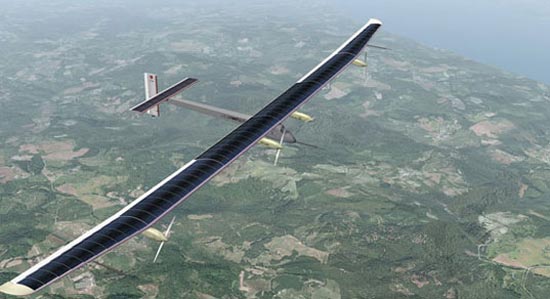Solar power transportation, at night?! The future of commerical air flight.
 Thursday, July 29, 2010 at 8:33AM
Thursday, July 29, 2010 at 8:33AM ...link via Kendall Crever
Now, this is still far off, but pretty impressive. We are not going to be flying in carbon neutral planes tomorrow to go visit the aunts and uncles, but it could very well be in our life time, and the first steps are being put in place right now. A Swiss Company named Solar Impulse, has successfully tested a solar powered airplane that lasted in flight for over 26 hours, including through the night on July 7th and July 8th. Their overall goal is an around the world flight via solar power, and a trans-atlantic flight by 2012. The craft flew just over 28,000 feet above sea level, and the wingspan of 208 feet same as a Boeing 747-400. This was just a lightweight prototype, but it shows that the technology is sound by staying aloff for 26 hours. It set records for the longest and highest solar powered flight. How does the power work? According to the Energy Efficiency & Renewable Energy, part of the U.S. Department of Energy:
"The aircraft's nearly 12,000 silicon mono-crystalline solar cells—mounted on its wings and on its horizontal stabilizer—absorbed the sun' rays on the ascent and supplied the craft's four electric engines and lithium-polymer batteries, enabling Impulse to average about 26 miles per hour for the flight"
 The Solar Impulse HB-SIA in action, in the great blue yonder.What are the implications of this for you and I. Like I said before, these are babysteps, but they are important movements towards commercial aircrafts using this technology to create carbon-neutral flights for you and I. According to the Carbon Footprint Calculator at Terrapass a round trip for 2 to JFK Airport in New York from LAX Airport in Los Angeles would be about 3,468 pounds of CO2. If we can cut into that number in the future for normal passenger flights using this technology it would be a great victory. Right now the airline industry accounts for about 12 percent of all of the CO2 released into the atmosphere. This technology is a step in the right direction, and is exciting in a very nerdy type of way (the way I like it). I hope to see more developers get into this arena and hope to see solar panels on my flights in future years to come.
The Solar Impulse HB-SIA in action, in the great blue yonder.What are the implications of this for you and I. Like I said before, these are babysteps, but they are important movements towards commercial aircrafts using this technology to create carbon-neutral flights for you and I. According to the Carbon Footprint Calculator at Terrapass a round trip for 2 to JFK Airport in New York from LAX Airport in Los Angeles would be about 3,468 pounds of CO2. If we can cut into that number in the future for normal passenger flights using this technology it would be a great victory. Right now the airline industry accounts for about 12 percent of all of the CO2 released into the atmosphere. This technology is a step in the right direction, and is exciting in a very nerdy type of way (the way I like it). I hope to see more developers get into this arena and hope to see solar panels on my flights in future years to come.
Whole article from the EERE can be found here:
Swiss Solar-Powered Plane Makes First Night Flight
---Justin J. Stewart (link via Kendall Crever)
 Justin |
Justin |  2 Comments |
2 Comments |  airplanes,
airplanes,  co2,
co2,  solar,
solar,  transportation in
transportation in  solar power,
solar power,  transportation
transportation 